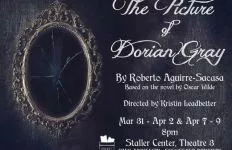photo from Facebook.com
By Kaitlyn Martin
Contributing Writer
Can it still be called ‘aging gracefully’ if the devil himself is the only one keeping you young? Dorian Gray, who keeps his youth through a heinous covenant with Satan, would certainly agree.
A little blackbox theatre at Stony Brook University’s Staller Center came alive with a night of drinking, drugs and debauchery for “The Picture of Dorian Gray.” And, of course, any adaptation of Oscar Wilde’s novel would be incomplete without a strong writer, Roberto Aguirre-Sacasa, and an equally-talented director, Kristin Leadbetter, to provide a long, bloody string of murders.
Run by The Stony Brook Pocket Theatre, the play takes us around the world— from London to Los Angeles— in the span of 18 years, chronicling the death spiral of Dorian Gray’s morality. When Dorian (Spencer Flash) first lays eyes on a downright gorgeous painting of himself done by Basil Hallwood (Christian Sutter), he sells his soul on the spot. The name of the game is amorality for immortality, and Dorian is in it to win it. He methodically murders his way through life, irrevocably obliterating his soul, for a chance at eternal beauty. While he remains young and manicured, his painting deteriorates.
A constant stream of sarcasm and wit provided by Harry Watton (Benjamin Balmaceda) offset Dorian’s intense and increasingly disquieting behavior, resulting in a surprisingly pleasant combination of humor and horror. Crude commentary occasionally provided by Alan Campbell (James Iofe) and biting sarcasm that hurt my feelings from Victoria Frost (Sydney Day) only added to the show’s appeal.
Whether it be from scene to scene or year to year, the show’s transitions were crisp, having an actor address the audience directly to give some context allowed for admirably comprehensible leaps through time.
In a similar manner, actors would step out from a scene frozen behind them to give the audience insight into any inner thoughts and feelings they may have. This insight eliminates some of the guesswork and gives characters a certain depth that is rarely provided so openly.
Audience members clamored when Dorian breaks it off with fiancée Sybil Vane (Paige Borak) in a manner that was so cold it had me feeling a little crushed. Sybil addresses the audience as she puts her shoes back on after being unceremoniously chased out of Dorian’s home. In that moment, she looked so sad and small, my heart was aching for her.
“He loves me,” she said with as much uncertainty as you could possibly imagine, and then some. “Didn’t he - doesn’t he?” Her distraught face fading out with the light is the very last time we see Sybil Vane, and the image is still imprinted in my mind.
Running at about two and a half hours, “The Picture of Dorian Gray” takes you on a wild ride full of sex, drugs and murder. What more is there to ask for?


